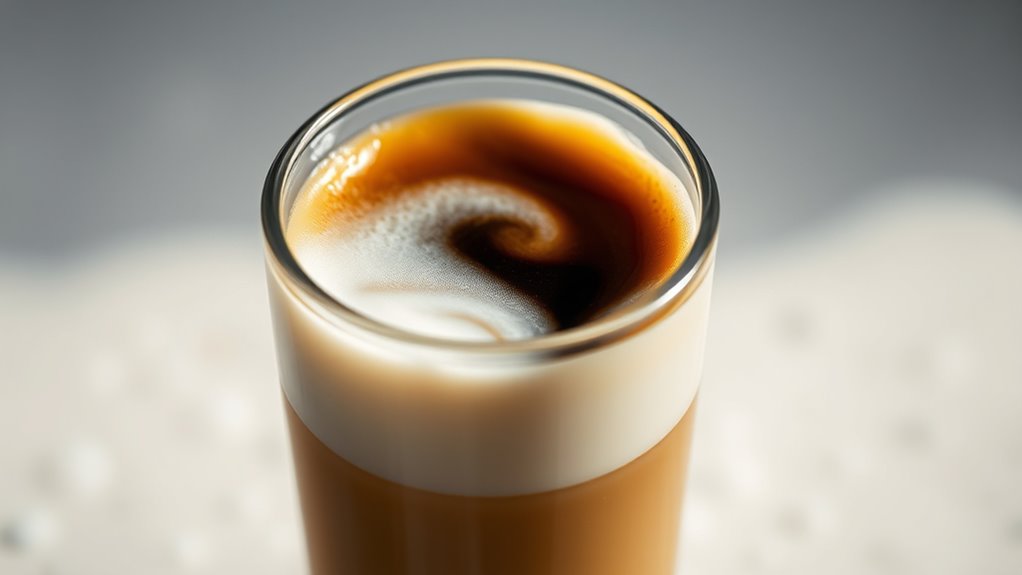When you combine espresso and milk, the chemistry involves proteins, fats, and heat. Proteins denature around 140°F, forming a network that traps air for microfoam, while fats help stabilize bubbles, creating creaminess. Proper steaming heats milk evenly, allowing the proteins and fats to work together for smooth texture and stable foam. Understanding these processes helps you craft better lattes and cappuccinos—stick with it to discover how perfect balance is achieved.
Key Takeaways
- Milk proteins denature at around 140°F during steaming, creating a network that traps air for microfoam formation.
- Fats in milk stabilize foam by cushioning bubbles, resulting in creamier, more durable froth.
- Proper heating and steaming techniques optimize molecular changes, enhancing milk’s blending with espresso.
- The interaction of milk proteins, fats, and minerals influences flavor, mouthfeel, and foam stability in espresso drinks.
- Controlled molecular changes during steaming produce smooth microfoam, improving the drink’s texture and visual appeal.

When you combine espresso with milk, understanding how milk’s proteins, fats, lactose, and minerals interact is vital to achieving the perfect drink. Milk’s composition influences how it behaves during steaming and how it creates the ideal foam for your latte or cappuccino. The proteins in milk, mainly casein and whey, play an essential role in foam formation and froth stability.
During steaming, these proteins undergo protein denaturation, a process where they unfold due to heat, enabling the formation of a fine, stable microfoam. This microfoam is fundamental for latte art and contributes to the smooth, velvety mouthfeel of your coffee.
Steaming milk heats it to around 140°F, which causes specific changes in its molecular structures. As the proteins denature, they form a network capable of trapping air, creating foam. The fats in milk further influence this process; whole milk, with its higher fat content, produces a creamier, more stable froth compared to skim milk. The fats help cushion the bubbles, preventing them from popping and maintaining froth stability over time.
This interplay between milk’s fats and proteins determines the foam’s texture and longevity, directly affecting the visual appeal and tactile experience of your espresso-based drinks.
Foam formation begins with steam introducing air into the milk, leading to the creation of microfoam—tiny, uniform bubbles that give the milk its silky consistency. Achieving this consistency requires understanding milk’s molecular structures: the proteins form a scaffold that stabilizes the foam, while the fats influence the bubble size and richness.
Proper steaming technique ensures that milk heats evenly, avoiding overheating that can cause excessive protein denaturation and resulting in a less desirable foam. The milk’s molecular structures, when correctly manipulated, foster a harmonious espresso-milk interaction, enhancing both flavor and texture.
Understanding the role of heat and how it affects milk’s components is crucial for baristas aiming to perfect their craft. Your goal is to optimize this interaction by controlling steaming and understanding milk’s composition. The proteins, fats, and minerals all contribute to how well the milk can blend with espresso’s acidity and temperature.
When done correctly, the result is a balanced beverage with a harmonious flavor profile, smooth mouthfeel, and appealing look. Knowing how milk’s components respond to heat and how they influence foam stability empowers you to craft espresso drinks that aren’t only delicious but also visually stunning.
This chemistry is the foundation for mastering a perfect espresso and milk combination.
Frequently Asked Questions
What Happens if You Add Milk to Espresso?
When you add milk to espresso, you create a richer, creamier drink. The dairy proteins interact with coffee compounds, balancing acidity and enhancing flavor without changing their structure.
Heating increases lactose solubility, making your beverage sweeter. The proteins remain stable, preserving the smooth mouthfeel.
Caffeine stays unaffected, so your drink retains its energizing effect. Overall, milk transforms your espresso into a more balanced, enjoyable experience without compromising its core qualities.
Is Adding Milk to Coffee a Chemical Reaction?
When you add milk to coffee, it’s mainly a physical process, not a chemical reaction. You’re mixing two substances, causing emulsification and blending, but the milk’s proteins and fats stay chemically unchanged at normal temperatures.
No new compounds form, unlike cooking or roasting. While some interactions like protein unfolding happen temporarily, they’re reversible. So, the process involves physical mixing, not chemical changes.
What Is the Science Behind Frothing Milk?
You’re curious about the science behind frothing milk. When you steam milk, heat causes proteins like casein and whey to unfold, creating a network that traps air and water, forming foam.
The fat globules add stability, while heating increases sugar solubility, influencing sweetness.
Proper technique, including correct temperature and wand position, helps you achieve a smooth, velvety microfoam with the right texture and stability.
Do Italians Put Milk in Their Espresso?
You’re wondering if Italians add milk to their espresso, right? Generally, they don’t. Italians prefer their espresso black to enjoy the pure coffee flavor.
Milk-based drinks like cappuccino and latte are common but reserved for breakfast and made separately.
When you order a macchiato, a tiny bit of milk or foam is added, but the standard espresso remains plain and unadulterated, emphasizing the coffee’s natural taste.
Conclusion
Now that you understand the chemistry behind espresso and milk, you can appreciate how their interaction creates the perfect balance of flavors and textures. By combining the right temperature, acidity, and proteins, you reveal a rich, creamy experience in every sip. So, next time you make a latte or cappuccino, remember the science behind it. It’s this fascinating chemistry that transforms simple ingredients into a delicious, comforting drink you’ll enjoy even more.









